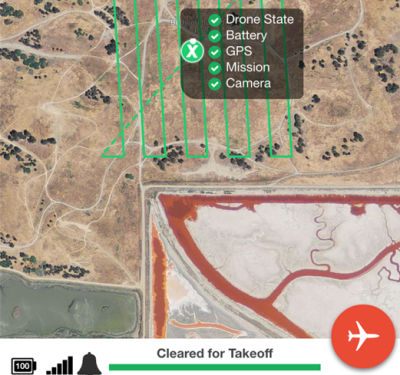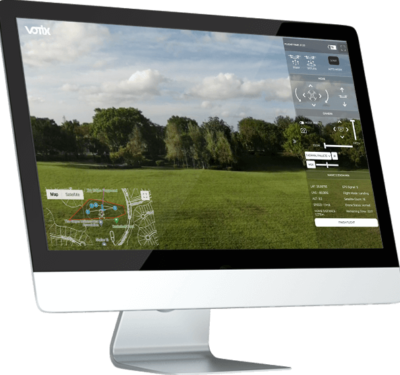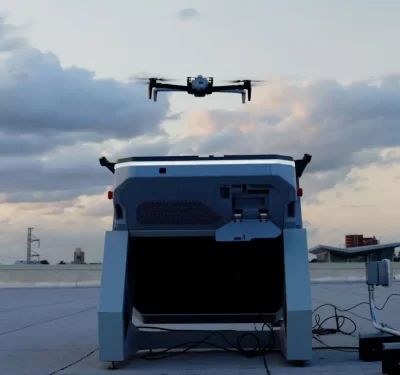
Official Photo – MGen James Poss (U.S. Air Force Photo by Andy Morataya)
If the Air Force had let me order custom t-shirts for everyone back when I was helping manage our unmanned fleet, I would have ordered a bunch of them printed with “It’s the data link, Stupid” to remind everyone of the BIG difference between manned and unmanned aircraft – the data link. In the early days of drone warfare, link issues were THE technical problem to solve. I can still remember getting a phone call while in Kuwait informing me that Colonel ‘Snake’ Clark at the Air Staff had “appropriated” one of my satellite terminals for a project. The day after 9/11 I found out it was to control an armed Predator drone from thousands of miles away during the hunt for Osama Bin Laden.
Beyond line of sight (BLOS) data links revolutionized air power. Before BLOS links, few commanders wanted drones because drones with line of sight (LOS) links couldn’t fly very far into enemy territory. After BLOS links became possible, the Air Force could not only hit targets anywhere with drones, but we could also station our pilots/sensor operators efficiently in safe, central locations vice deploying them at more risk with their drones. More importantly, we could send the reconnaissance data anywhere we wanted, almost instantly. Like when we switched Sentinel 2 (our intelligence downlink site in California) from interpreting drone data from Afghanistan to NATO over Libya in a matter of precious moments to help our Japanese allies diagnose damage at the Futenma nuclear reactor. No airmen deployed. Just electrons. BLOS links let the Air Force save massive funding by switching to centralized enterprise solutions for their drone pilots, intelligence analysts, and data.
As the commercial drone industry ventures into the complicated realm of BLOS , they will learn the same lesson as the Air Force did about data links. As we’ve discussed in previous articles, the new FAA Part 107 rules don’t allow drone BLOS operations without a waiver. We also discussed how giving drones a detect and avoid (DAA) capability is one of the two big problems in safe BLOS flight. The other problem is how to reliably extend data link ranges to control drones over long distances. The FAA will insist that drones operating BLOS maintain an extremely reliable link with their ground stations throughout their flight profile, no matter how far they fly from their remote pilot’s location. Reliable links are absolutely critical to BLOS drone operations.
The Air Force solved their long-range data link problem with satellite links that allow worldwide enterprise operations. The MQ-1 Predators flown after 9/11 carried small satellite transceivers, just like the much larger transceivers CNN deploys to beam news back via satellite. Trust me – this isn’t cheap and won’t be affordable for commercial drone operations, at least not in the near future.
The solution may lie in another type of link network the Air Force set up in Afghanistan; a ground relay LOS network. When satellite links got too expensive even for the DoD, the Air Force mounted LOS links on a series of towers connected by microwave. As the drone moved, it’s link would “daisy chain” from tower to tower until the drone reached its mission area.
A commercial drone ground relay LOS network would have advantages and disadvantages compared to the Air Force system. Advantages are that existing cell phone tower networks are ideally positioned to provide the backbone for ground relay LOS networks for commercial drones. Cell phone companies have already leased the land, dealt with all the FCC regulatory restrictions and, most importantly, obtained the spectrum that could be used for BLOS drone link operations. They also have world class cyber defense centers. The disadvantage is that today’s providers struggle to get enough bandwidth for existing cell phone coverage as it is, their cell tower antennas point down to cover ground users, vice up to cover drones, and their 4G link reliability won’t be high enough to satisfy FAA BLOS requirements. For something as critical as BLOS drone control, the FAA won’t tolerate ‘dropped calls’. It’s that reliability thing, again.
And again, Air Force experience might help with these problems. The Air Force uses directional antennas that automatically follow their drones to increase link reliability over omnidirectional antennas. They have also learned to separate the drone control link itself from the mission payload link. The RQ-4 Global Hawk can easily consume over four megabits of bandwidth transmitting high resolution imagery to its Sentinel Station, but only needs a few kilobits of bandwidth for its remote pilots to control the aircraft. That’s because Global Hawk is very autonomous. Rather than telling the Global Hawk how to move its control surfaces and throttle, the pilot just tells it where to go and the Global Hawk figures out how to get there autonomously. Hence, industry could get highly reliable drone control links using directional antennas mounted on cell towers with commercially available spectrum for the low bandwidth C2. The mission payload could then use the existing 4G network to offload data at the reliability of commercial 4G service; a low risk option because payload links aren’t critical to flight safety.
Problems would remain even with this type of system. Although low bandwidth directional drone links using commercially available spectrum wouldn’t use scarce 4G service spectrum, they would take up physical space on already overcrowded cellphone towers. Directional antennas are expensive and must be positioned carefully to avoid radio frequency interference. However, the two big, but solvable, problems for a commercial drone network are creating a business model and then figuring out how to regulate it for drone use. The cellular companies might view a drone link network as too expensive and risky to invest in compared to their flagship cell phone services. Today, trends suggest the big aerospace companies view commercial drones the same way; why invest if they’re riskier than either military drones or manned aircraft, particularly when the regulatory environment is unclear? And how WOULD the FAA regulate a drone link network? The control portion would definitely be an aviation safety critical system, but would the FAA even have the authority to regulate a hybrid system using cellular communications? Doesn’t the Federal Communication Commission handle cell phones? It’s an interesting battle space for an unexpected interagency dispute.
Then there are the cyber problems and here Air Force experience doesn’t provide easy solutions. We’ll discuss these issues in depth in later articles, but the secret sauce is to make links that are both reliable and secure. It’s easy to have one or the other, but not both. Generally, the less encryption a link uses, the more reliable it is. Encryption requires lengthy “handshakes” for link nodes to establish identity, then it uses encryption keys to establish a secure link. Too many things can get bungled with an encrypted link. The nodes can fail their handshakes, making it impossible to establish a link. The complicated keys must be the precisely the same on both sides and some human (probably named Murphy) inevitably keys the wrong key at some point. Encryption can also introduce control latency, meaning it could take several seconds for a remote pilot to transmit commands to their BLOS drone. Without some form of encryption, hackers can easily intrude on a drone link and possibly take control of the drone itself. Even the Air Force struggles with this problem because the more secure they make their links, the more control latency and potential for link loss they introduce. At least with today’s technology. Air Force Predator pilots routinely deal with a five to eight second delay on their controls when flying BLOS due to encryption overhead and the time it takes to relay commands via satellites. That’s another ingredient that doesn’t work yet for the palate of ubiquitous commercial operations.
These challenges aside, I’m confident that industry will find ways to make truly secure and extremely reliable drone data link networks to enable BLOS drone operations. There is simply too much money (and human progress) to be made in BLOS drones verses visual line of sight (VLOS) drone operations. For example, to cover the Mississippi Delta with drone imagery to provide precision agriculture data using VLOS drones, it would take nearly 1,000 drone sorties. An LOS drone could do the job in 10 sorties. A BLOS drone could cover the Mississippi, Louisiana, Arkansas and Tennessee deltas in a single sortie. Keep in mind, drones connected to a drone data link network can use enterprise solutions for their aircrew and data processing. Pilots flying precision agriculture over the Delta could live in New Orleans and send data to world-class agricultural institutions like Mississippi State University, Auburn University, and Louisiana State University. Only the drone would have to move to provide Delta farmers the data they need.
These networks, combined with ground and airborne DAA systems will add the technical safety layers necessary to fly drones beyond the human’s line of sight. Part 107 regulations are a great start for smaller drone operations in the United States, but we won’t have a truly viable industry until we can find a safe way to fly BLOS. Just remember – it’s the data links, Stupid. No link, no drone!






